153 Squadron Clyde Willis Byers Crew - Page 1
Home Page 1 Page 2 Guestbook Contact us
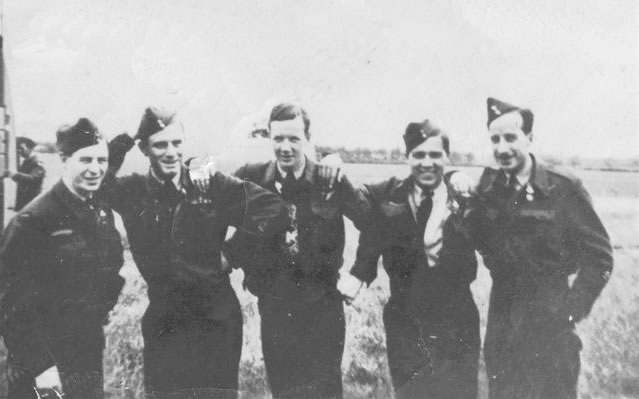
Left to Right: Fred Irving, Clyde Byers, Robert Shilliday, Michael Frank, Robert Crow
Images above and below, and identifications courtesy of Jim Shilliday, brother of Robert Charles Shilliday.
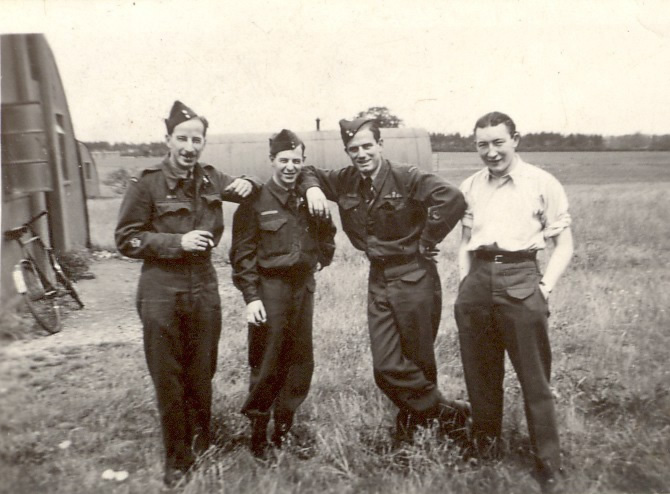
Left to Right: W/O Bert Crow (wag), F/S Fred Irving (bomb aimer), F/O Clyde Byers (pilot), Sgt. Ernie McLeneghan (nav). |
Introduction
Leaving Scampton at 1730 to join aircaft from other Squadrons at the bomber stream concentration point Sudbrooke, 16 aircraft were sent to attack the Braunkohle-Benzin synthetic oil plant at Zeitz (about 30 miles south-west of Leipzig) on the 16th. For once, the weather was clear. Good ground-marking by PFF assisted an accurate and concentrated attack, hindered only by moderate flak and slight fighter activity. During this raid, F/O Clyde Byers RCAF whilst flying in PB 872(P4-2ndX) was posted missing, together with his four Canadian and two RAF fellow crew members, lost without trace. all are commemorated on the Runnymede Memorial.
Source: http://crivensjingsandhelpmaboab.blogspot.com/2010/01/153-sqn-16th-jan-1945-zietz_16.html. Thanks to Alistair for this.
16-17 January 1945
Zeitz: 328 Lancasters of Nos 1, 6 and 8 Groups. 10 Lancasters lost, 3.0 per cent of the force. The target was the Braunkohle-Benzin synthetic-oil plant near Leipzig. Much damage was caused to the northern half of the plant.Total effort for the night: 1,238 sorties, 30 aircraft (2.4 per cent) lost. |
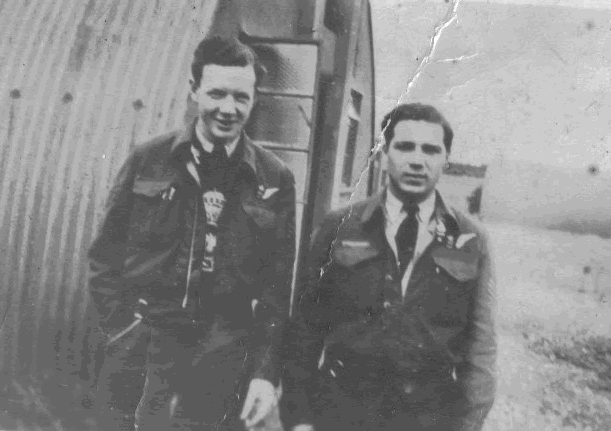
Left, Robert Charles Shilliday and right, Michael Frank, tail gunner in 1944, during conversion training to Lancasters, in front of a Nissan Hut.
Image provided courtesy of Jim Shilliday, brother of Robert Charles Shilliday. |
Source: The Bomber Command War Diaries' - M. Middlebrook / C. Everitt
|
Lost Without Trace NG 335, PB 872(P4-2ndX)
F/O Clyde Willis Byers, pilot, RCAF please click here to see the last post for F/O Byers
please click here to see the last post for F/O Byers
Sgt John Barry Mortimer Kelleher, flight engineer, RAF  please click here to see the last post for Sgt. Kelleher
please click here to see the last post for Sgt. Kelleher
F/S Eric Charles McLeneghan, navigator, RAF  please click here to see the last post for F/S McLeneghan
please click here to see the last post for F/S McLeneghan
F/S Frederick Cleaveland. Irving, bomb aimer, RCAF  please click here to see the last post for F/S Irving
please click here to see the last post for F/S Irving
WO1 Robert King Crow, wireless operator, RCAF  please click here to see the last post for WO1 Crow
please click here to see the last post for WO1 Crow
F/S Robert Charles Shilliday, mid-upper gunner, RCAF  please click here to see the last post for F/S Shilliday
please click here to see the last post for F/S Shilliday
F/S Michael Frank, rear gunner, RCAF  please click here to see the last post for F/S Frank
please click here to see the last post for F/S Frank
The description below is excerpted from Chapter One of Jim Shilliday's forthcoming book about his brother. The working title is My Brother's Ghost: The Life and Times of a Missing Airman. Click here to read his article in the Winnipeg Free Press, 'My ghost brother coming back to life.' Our thanks to Jim for providing this, and the excerpt from Chapter 1, which follows below:
My Brother's Ghost: The Life and Times of a Missing Airman by Jim Shilliday
Jan. 16, 1945—The control officer standing in the chill winter dusk gives the green flash at 1735 hours, and the leashed rumble of its four Packard-Rolls Royce Merlin engines promises enough power as Lancaster bomber NG 335 towers above the tarmac, its seven-man crew ready to go, for the thirteenth time.
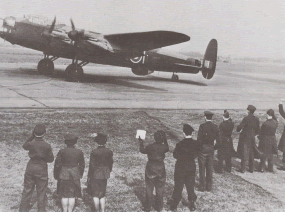 |
In the cockpit, Flying Officer Clyde Willis Byers sticks his left hand out the tiny side window, just above the plane’s name, “P for Peg”, and wiggles his fingers at the gaggle of station personnel that, pouring rain or not, always gathers to wave good luck to bomber crews, shoves forward the throttles with his right hand and the giant moves through the viscid air of mid-January to the runway’s end for a last quick cockpit check of mixture, pitch, flaps and fuel then erupts with power as the throttles are shoved forward for take-off. Outer engines alternately advanced or reduced to stop her swinging, full power now, controls forward to raise the tail so the rudders can take over from the throttle juggling, speed builds to the “point of no return”—90 knots—and then the heavily bomb-laden clumsy plane is magically light, unsticks, rises from RAF Scampton, Lincolnshire, and becomes a bird in its element, now heading towards another of the largest air battles of all time. |
Image of bystanders waving to departing Lanc crew from the book 'Lancaster.'
As all the bomber pilots had fingered switches and eased throttles forward, flames had ignited in the hundreds of cylinders and the familiar groan, shudder and then bass roar combined into a steady thunder as the hot exhaust fumes of burnt petrol and gasified oil of 16 aircraft roiled in the prop-wash and transformed the tarmac into a scene a drunk would appreciate, planes and men on the ground stretching grotesquely in the distortion, then steadying and becoming even as the bombers trundled away towards the end of the runway, leaving a pungent odor. They took off singly, banking low and searching to join up loosely and drone to the concentration point, trailing traces of black smoke for miles.
The seven-man crews, most of them in their late teens or early twenties, had swung themselves up into the aircraft through the main door in the back, or up a ladder near the nose into the sardine-tin fuselage and the stink of kerosene used to wash out the aircraft detritus after every trip. Then their world was a tight one, squeezing into gun turrets, barking shins on spars and tripping over their mates’ legs. Hours of strain, high-volume noise, bitter cold, minutes of frightening activity, heart-stopping emergencies and then—if they held the right hand—a return to tranquil safety and a fried egg for breakfast. This Russian-roulette routine was repeated until their tour of 30 raids, or more, was completed—or they were dead.
Apprehension and fear that these boys and young men in NG 335 fought down night and day lifts temporarily as they concentrate on readying themselves and equipment for action with an unforgiving enemy over Europe. Their squadron’s motto, Noctovidus—We See By Night—they interprete with half grins, “There’s Always Bloody Something!” Having all checked in on the intercom, made adjustments, the air gunners test-firing over the North Sea, now the crewmen were just grey shapes in glowing instruments or the occasional flash of a penlight: pilot, Flying Officer Clyde Willis Byers, 21, (Lunenburg, Nova Scotia), RCAF, at the controls; Flt. Sgt. Robert Charles Shilliday, 19, (Winnipeg, Manitoba), RCAF, crammed into the mid-upper gun turret, canopy-covered head and shoulders into the now-starred sky, lower body slung below; Sgt J. B. M. Kelleher, RAF, flight engineer; Flt. Sgt. E. C. McLeneghan, RAF, navigator beneath his astrodome; Flt. Sgt. Frederick Cleaveland Irving, 23, (Hillsboro, New Brunswick), RCAF, bomb aimer, in the nose; Warrant Officer Robert King Crow, 21, (Fort William, Ontario), RCAF, wireless operator (whose radar may cause sinister problems for this very flight) ; Flt. Sgt. Michael Frank, 21, (Prud’Homme, Saskatchewan), RCAF, rear gunner (tail-end Charlie), the loneliest and coldest gunner.
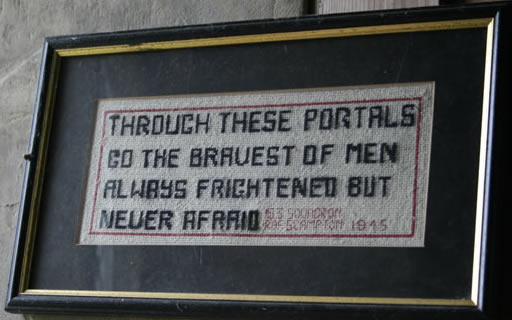 Image courtesy of Alistair at help ma blog |
Perhaps the crew was more nervous tonight (“Always frightened, never afraid!”) because it was their thirteenth sortie, and everyone said that a dozen raids was the average life expectancy in Bomber Command. (Besides, since D-Day almost eight months ago, U.S. First and Third Armies had linked up after winning the Battle of the Bulge, and Soviet troops had captured Warsaw, and surely this bloody war would soon be over and done). They were one of sixteen 153 Squadron Lancs (Lancaster Mark 1s and 3s) in a force of 328 Lancasters of Nos. 1, 6 and 8 (Pathfinders) Groups heading for the bomber stream concentration point near Sudbrooke, where they would make a feint off target, then turn to attack the Braunkohle-Benzin synthetic oil plant at Zeitz (deep, really deep, inside Germany, about 30 miles south-west of Leipzig). |
Bomber Command's Lancaster Squadrons had been temporarily under the command of Gen. Dwight “Ike” Eisenhower, Supreme Allied Commander, during the spring and summer of 1944, and spent much of their time supporting the invasion of France and Germany. Tonight’s total bomber force would use up roughly 700,000 gallons of petrol, 23,000 gallons of oil, 1,300 gallons of coolant, 1,500 tons of bombs (a few months earlier, war correspondent Edward R. Murrow had described his bombing flight in an RAF Lancaster as: “A thing of orchestrated hell—a terrible symphony of light and flame”), 3,000,000 rounds of ammunition, 5,000,000 litres of oxygen, 2,500 pints of coffee, and 2,000 pounds of food.
NG 335 had taken off on the relatively new concrete runway at Scampton, a permanent RAF airfield (one of the few that first felt prop-wash during the First World War) now famous amongst those in the loop as the home base of No 617 Squadron (originally Squadron X, for secrecy), the fabled Dam Busters, whose attack a year and a half earlier breached the Edersee Dams using a specially developed “bouncing bomb” causing catastrophic flooding of the Ruhr valley and of villages in the Eder valley. It was a dramatic raid designed to impress mightily not only the leaders of Nazi Germany, but also all the Allied fans at home.
Home Page 1 Page 2
Guestbook Contact us
153 Squadron Byers Crew - Page 1




